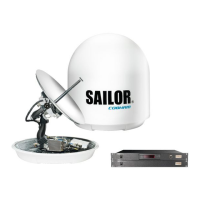Calibration
99-145912-A Chapter 6: Configuration 6-7
2. Click Apply.
Acquisition process and search pattern
With heading input or fixed heading
1. The antenna starts the acquisition and searches for 10 seconds at
the expected position. If RX lock is detected the antenna goes to
Tracking.
2. If no RX lock is detected, a box search pattern is started and the
positions where RF power can be received are stored.
Heading input Description
External Heading input from the vessel’s gyro compass (default).
If there is no heading input due to failure, alarms are raised and the
antenna continues in gyro-free mode. When heading input is available
again and a new acquisition is made, alarms are cleared. See also About
operation in gyro-free mode on page 6-14.
Fixed Use this setting for making an azimuth and cable calibration if there is no
input from the vessel’s gyro compass and for permanent installations like
remote areas or oil rigs, or during training and test.
Important: Fixed heading is not allowed for sailing vessels!
Enter the vessel heading in degrees.
None I
mportant: You must make an azimuth and cable calibration
with Fixed before you can use this setting. This is required in
order to be able to use blocking zones. After a successful
azimuth and cable calibration you must change the heading
input setting from Fixed to None.
Select this setting after a successful azimuth calibration with Fixed
heading if the system does not have input from the vessel’s gyro
compass. See also About operation in gyro-free mode on page 6-14.
Table 6-2: Heading input options
If you change the heading settings from external to fixed or
vice versa you must make a new azimuth calibration.
Figure 6-6: Acquisition, search pattern
VHFRQGV

